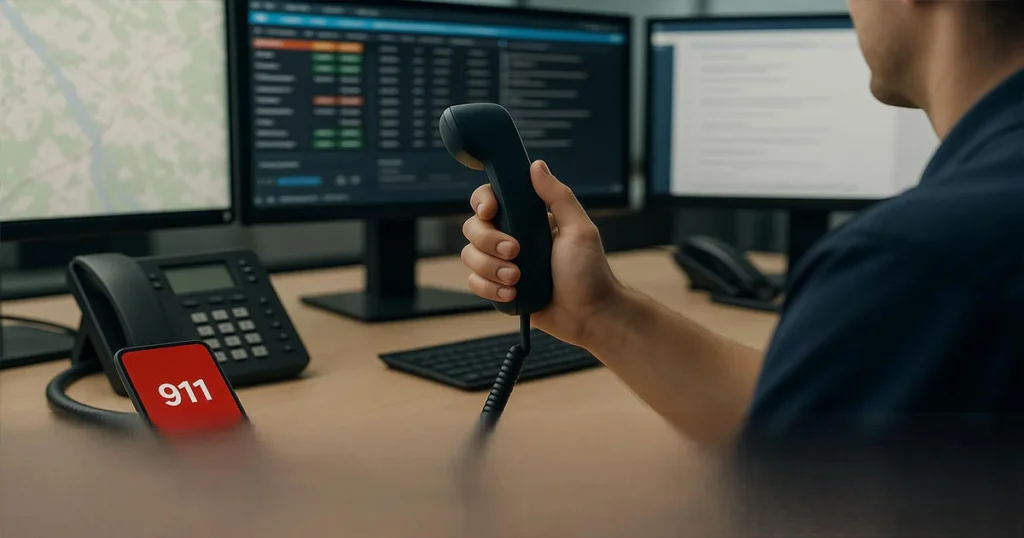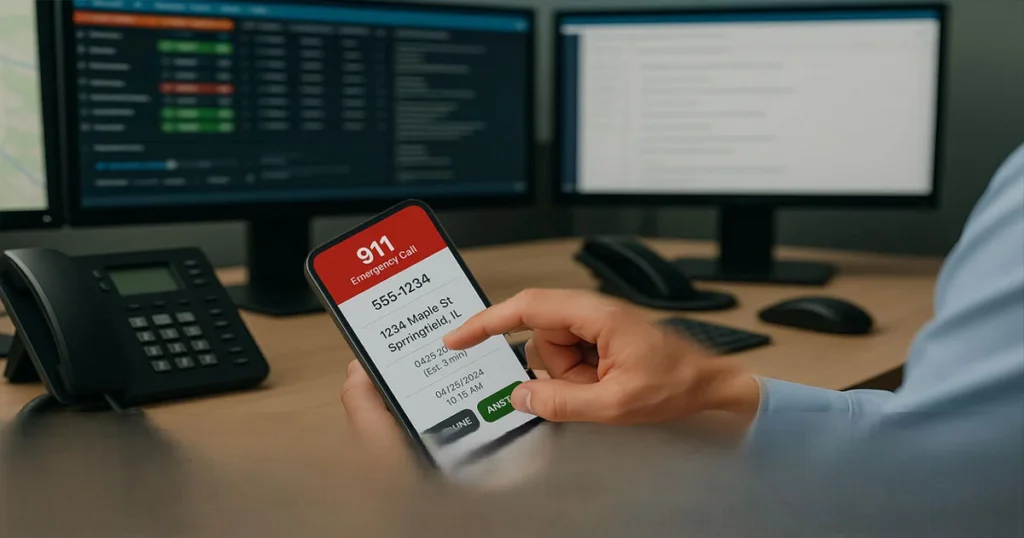Marcus was riding his motorcycle last Tuesday night on one of the wavy back roads outside Phoenix, and crashed. He was dazed and covered with blood and could not indicate to the 911 operator where he was to the operator. But his iPhone had already. Paramedics located him at the place his phone’s GPS indicated in just seven minutes. Marcus could not have made it through that crash 20 years ago. He is at home with his family because of the 911 technology that was unimaginable some years before.
The new 911 technology uses GPS satellites, phone sensors, and digital networks to locate a caller within 15 feet. This is faster than the old systems that were guessing in the form of miles. People are now reached by the emergency crews 45 percent faster, which literally saves more lives in case of heart attack, accidents, and other emergencies.
What Changed Everything About Emergency Calls
Remember when calling 911 from your cell phone was useless for location help? The operator would ask where you were, and if you didn’t know, you were pretty much out of luck. Those frustrating days are mostly behind us now.

I talked to Linda, a 911 dispatcher in Cleveland who’s worked the phones for fifteen years. She remembers nights when callers would cry, “I don’t know where I am!” and all that was there on her screen was a huge circle that covered half of the city. Said she, That was the worst phone call I ever had. You so desperately wanted to be able to help, but the technology was not up to that at all.
It all began to change sometime in 2015 when smartphones became smart enough to be emergency beacons. Your phone now does things during a 911 call that would blow your mind.
How Your Phone Becomes a Life-Saving Device
The moment you dial 911, your smartphone turns into something like a high-tech search and rescue tool. This is actually what occurs in the first few seconds that most people will never notice.
The GPS satellites communicate with your phone through 12,000 miles of Earth’s surface. However, that is not all. The gadget also searches all Wi-Fi networks available, the distances between you and various mobile towers, and even accesses internal attendances and movement sensors.
You can think of it as the same as five different people who all know where you are. GPS tells you that you are in a given location, Wi-Fi data validates it, cell towers support the information, and your phone sensors fill in the last details.
Solving the Indoor Emergency Problem
Buildings used to be like dead zones for emergency calls. Concrete walls and steel beams blocked GPS signals, leaving dispatchers guessing which floor you might be on in a 30-story building.
The breakthrough came from an unexpected place: shopping mall navigation apps. One thing that engineers discovered that they could do is use the same WiFi mapping technology that guides you to the food court, and use it to send paramedics to care once you experience a heart attack.
Your phone has become aware of Wi-Fi connections and Bluetooth messages within structures, forming a digital image of where you truly are. The new systems are able to tell the dispatchers where you are in a building, not a building, but a floor and even a room.
Why This Matters More Than Ever
Emergency calls have gone up 30% in the past five years. More older folks living alone, more people aware of when to call for help, and frankly, more accidents as life gets busier and more complicated.
The math on emergency response is brutal but simple. Every minute you wait for help during a heart attack drops your survival chances by about 10%. For stroke victims, brain cells die by the millions with each passing minute. Better location technology doesn’t just make things more convenient – it determines who lives and who doesn’t.
Real Stories from the Front Lines
Er Dr. Jennifer Walsh in Atlanta works in emergency medicine. She’s seen the difference firsthand. The patient would fall, and paramedics would not be able to retrieve them after fifteen minutes or so, creating a situation of patients coming into the emergency with a fifteen or twenty-minute delay, she explains. It is now five to eight minutes, and we can save people that we would have lost previously, said Chief Sean Woods.
Fire Captain Mike Rodriguez in Sacramento tells similar stories. Time is vital in evacuation and rescue in case of fire in apartment buildings. His crews now get building layouts, hydrant locations, and optimal entry routes sent to their trucks before they even arrive on the scene.
The technology has been huge for police work, too. Detective Sarah Kim in Portland describes how they located a kidnapped teenager last month using her phone’s location data shared with 911. “We had her exact coordinates updating every few seconds,” she says. “We found her within two hours instead of days.”
How the New System Actually Works
Walk into a new 911 center and you’ll be borrowing the atmosphere of a NASA mission control room. Dispatchers use computer stations that provide real-time maps, building illustrations, traffic information, and weather information, as well as live feeds from the scenes of emergencies.

Gone are the days when operators just took information and sent someone out. Dispatchers today are more like emergency coordinators who would control and coordinate various information streams so as to decide who should go where in a few seconds.
Multiple Ways to Communicate
Text message to 911 usage has revolutionized the world of people using their phones to communicate without speaking during emergencies. The victims of domestic violence are able to ask for help silently. Folks with hearing or speech problems finally have direct access to emergency services. Parents hiding from intruders can type instead of whispering.
But it goes way beyond texting. Some areas now accept photos and videos that show dispatchers exactly what’s happening. Someone reporting a house fire can send pictures showing which rooms are burning. The witnesses of car collisions can transmit photos, which can guide the medical workers to be prepared for what to expect.
These visual tools assist in the better decisions that need to be made by the dispatcher concerning what resources to mobilize and how to gear a responding crew in anticipating what they are walking into.
Smart Resource Management
The old way was pretty simple – take the call, send whoever’s available, hope for the best. Now, computer systems analyze dozens of factors in real-time to figure out the best response plan.
The system considers which units are closest, who has the right equipment, current traffic patterns, weather conditions that might slow things down, and even historical data about similar calls. It suggests the optimal response within seconds of getting the emergency call.
In large-scale events such as car crashes, the system would coordinate the police, fire, and medical services without them intervening in the affairs of one another and without them turning up with the wrong equipment.
Success Stories That Show the Difference
Hamilton County in Ohio provides a perfect example of how these upgrades work in practice. After installing their new system, location accuracy for cell phone calls improved by 35%, and average response times dropped by four minutes.
Four minutes might not sound like much, but it’s huge in emergency medicine. That time difference means the gap between full recovery and permanent disability for heart attack patients. It’s the difference between containing a kitchen fire and losing the whole house.
Medical Breakthroughs
Automatic crash detection on newer phones has created an entirely new category of life-saving technology. When your phone’s sensors detect a severe impact followed by no movement, it automatically calls 911 and shares your exact location.
This has been incredible for single-car accidents where drivers end up unconscious in remote areas. The phone makes the call they can’t make themselves, and tells responders exactly where to look.
Fall detection on Apple Watches has been similarly amazing for elderly people living alone. The device can tell the difference between normal activities and serious falls, automatically getting help when someone can’t reach their emergency button.
Search and Rescue Wins
First-hand accounts by mountain rescue teams reveal how the ability to make emergency calls, now available with the use of GPS services, has revolutionised their operations. In the past, when they had to scan large tracts of wilderness by descriptions, they could be furnished with exact coordinates, which would get them to stranded hikers.
Urban search and rescue has also improved tremendously. When there is a collapse of buildings or gas explosions, the first responders can go directly to the trapped persons without having to go through those structures, risking their lives going room by room.
In life, developing water contingencies, the Coast Guard units receive precise boat locations and reduce search time for our sailors and fiberglass boats in distress, which would otherwise take hours.
What’s Coming Next
The next generation of emergency technology will network your home, automobile, and personal equipment so you can develop a more responsive safety net.
Intelligent smoke detectors shall make an automatic report of fires, accompanied with room to room-to-room information of what is burning and how severe the problem is becoming. The gas levels will be sent to the carbon monoxide sensors so that first responders can be aware of the requirements of the safety equipment.
Tests suggest that the connected cars will automatically provide the details about accidents concerning their severity, number of people on board, and any airbags deployed. This data is used to allow dispatchers to determine which type of medical assistance to send: basic emergency response or full trauma team.
Artificial Intelligence Gets Involved
It is also developing machine learning systems that will listen to the words callers say and noises behind the scenes to assist dispatchers in determining the type of emergency and the degree of response. It is possible to identify panic in a voice of person or know the sounds in the environment that signify a certain situation.
The language aversions will be reduced with real-time translation services, and the writing process of converting voices to text will ease the operations of dispatchers who are hearing impaired.
Predictive systems will assist the emergency services in predicting the emergence of problems based on weather conditions, special events, and past patterns, and enable strategic positioning of resources.
Challenges That Still Need Solving
It is not a matter of turning on a switch to roll out this technology in all places. Each community has to deal with various challenges depending on its geography, the number of people, and the money they have.

Money Matters
Upgrading 911 systems can cost millions of dollars that smaller towns simply don’t have lying around. Hardware, software, training, as well as system maintenance costs soon accumulate among communities that are strained by their public safety budgets.
The federal grant programs assist, although the application is competitive and difficult. To be more creative, some locations team up with other towns and share facilities to establish regional emergency centers.
Another option is the idea of the public-private partnership, when tech companies will invest in infrastructure development in order to receive a long-term contract for services.
Training People for New Technology
Technology is as good as the users. New-day 911 dispatchers require a lot of training concerning sophisticated computer systems and communication systems that were not there when most of our veteran 911 operators began their careers.
The task of the job is no longer gathering basic data but leveraging several communication channels and analysis of real-time data from different sources. This is further complicated and thus demands more skilled personnel and well-rounded training sessions.
Most of these centers are offering frequent professional training as well as certification programs to ensure that their employees stay abreast with the fast-evolving technology.
Making Different Systems Work Together
Crisis does not listen to city limits or county lines. Ensuring that 911 systems are interoperable to allow them to communicate with each other remains a challenge because communities implement various technology solutions.
It is not simple to get thousands of separate emergency agencies to work together to have general standards. The regional cooperation schemes will be helpful in such a case since they will be able to establish the common processes as well as the technology platforms.
Privacy and Security Concerns
Improved tracking of location creates reasonable concerns regarding privacy and data security that communities need to balance with the necessity to enhance the level of public safety.
When you dial 911, it automatically gathers the data of your location as long as you are not set up with your regular privacy settings. This override allows the dispatchers to track you in case of an emergency, but it generates sensitive personal data that must be handled with caution.
In most locations, there have been stringent regulations regarding the manner in which location information is acquired, maintained, accessed, and ultimately destroyed. The retention periods of the data are short, and it is available only to authorized staff who have authentic business purposes.
Protecting Critical Infrastructure
The same emerges as 911 systems grow interconnected, and may also fall victim to cyber attacks that may topple the provision of emergency services. Such systems must be guarded by following all measures of security and being alert at all times.
Some of the security strategies comprise encoded communication, encrypted data centers, frequent security checks, and backup systems that could be used in the eventuality of primary networks becoming compromised.
Emergency response plans equip services in case of possible cyberattacks to plan how to continue serving during the attacks and rapidly rebuild their full capacities later.
Economic Benefits Beyond Public Safety
The payoff of the communities that invest in the advanced 911 technology revolves around the emergency response and covers the economic gains and savings in various aspects.
The rate of response is quicker, which lowers the intensity of medical emergencies, lowers the long-term health care expenditure, and enhances patient outcomes. Each minute that passes without reacting to a heart attack results in a shortening of the time in a hospital and rehabilitation costs.

A more efficient utilization of resources implies that more calls can be managed by the emergency services with the current number of staff and equipment. This enhanced production postpones or averts a costly increase in staff levels and motor vehicle fleet.
Faster fire emergency response saves millions of dollars in property damage. An earlier intervention prevents the spread of fire, and the use of water in putting out the fire causes water damage.
Insurance and Development Advantages
Insurance companies often offer reduced premiums to communities with advanced emergency services. Property insurance rates reflect improved fire protection and emergency medical response.
New emergency infrastructure gives business and residents a reason to view the town where they live as a place where they can be safe as well as enjoy their lives. This competitive advantage affects the choices of location by businesses and families.
In places with good emergency response competencies, the rates of property damage are relatively high. Proximity to higher levels of medical care and safety services is also an important selling point on the part of real estate professionals.
Looking at the Big Picture
The transformation of America’s 911 system represents one of the biggest advances in public safety technology we’ve seen in decades. We have moved human voice usage to high levels of support for the emergency response system that could only be a science fiction tale just a few years ago.
The figures provide a remarkable account. Response time has been reduced by a quarter to half, location accuracy is now accurate to the feet as opposed to miles, and the survival rates increase in nearly all forms of emergencies. Nevertheless, there is a life behind every statistic (or, more precisely, there is a real person behind every statistic) because people are grateful to save their lives. After all, aid came sooner and was more developed.
The technology improves more and more. The Internet of Things, artificial intelligence, and predictive analytics will lead to the development of emergency services that will detect issues before they can transform into crises and give a proactive rather than a reactive approach.
The big issue is not to come up with new technology but to ensure that every person can access such life-saving powers. All communities should have access to the kind of protection that the new 911 systems offer, and as such, the investment in emergency communications should remain at the forefront of the priorities of the public safety leaders across the board.
All you need to do is look at this three-digit number, 911, on the emergency dial pad on your phone. Consider the wonderful technology that occurs in the background that promises assistance in progress on the way when you need help, when you need it, and when it counts. The same technology is evolving day by day with just a single mission: to save more lives due to a better response to emergencies.
Frequently Asked Questions
How much better is the new 911 location technology compared to what we had before?
- New 911 systems can find you within 10-20 feet most of the time, compared to old systems that could only guess your location within several miles. That’s roughly a 99% improvement in accuracy. The new technology, even indoors where GPS is not as accurate, works in most cases to within 50-75 feet of where you are, which is far superior even to not having any indoor positioning capability at all.
May I send pictures or videos when calling 911?
- There are now a lot of regions that enable you to send photos, videos, and text messages to 911, although this is based on whether the emergency center in your area has upgraded to the next-generation systems or not. When that exists, you can display to the dispatchers what is happening, so that they can produce the appropriate help and give the responders an idea of what they may expect. To ensure that the type of communication available can accommodate you, visit the local 911 center to find out the communication options available in your area.
What will happen in case my cell phone battery runs out or I am out of cell range in the event of an emergency call?
- The system records your whereabouts even in the initial few seconds of calling, and this means that the dispatchers will be aware of your location even when you run out of phone battery later. The technology also attempts to keep you connected using alternative routes over the network, and it may automatically reconnect given a better signal. Nevertheless, it is prudent to provide as many details as one can at the beginning of the call in case.
Does this location tracking work when I travel or outside the family settlements?
- The technology can be used anywhere that it can get cell phone service, but it is likely to work better depending on the terrain and infrastructure available. The rural and mountainous regions may be more problematic due to the reduced cell towers, and the technology may have barriers to the use of GPS, but even far remote places tend to receive significantly better positioning than that offered by the older works. In some regions as well, the emergency communicator satellites become a backup in extremely secluded places.
What safeguards does the 911 technology offer to my personal information and privacy?
- The adaptation of location data is under carefully established regulations regarding collection and utilization by emergency services. The use of your information is limited to direct emergency responses only and is normally disposed of in less than 30-180 days by active systems as per local policies. No other agency provides the data or uses it to monitor what you do every day. The system enables emergency location services to run only when making a 911 call and not during normal calls.

